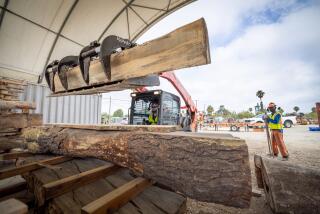U.S. Ready to Play Hardball With Hardwood Exports : Exports: The growing campaign to sell hardwoods to Japan and Europe can turn the tide of depression in Appalachia, association official believes.
MORGANTOWN, W.Va. — When Robert Conner looks at a stand of red oak, black cherry or maple rooted in the hills of Appalachia, he sees dollars for a chronically depressed economy and a way to ease the nation’s trade imbalance, especially with Japan.
“If we can increase the export of hardwoods, it will automatically provide jobs and make up for some of those cars the Japanese have been sending over here,” said Conner, executive director of the Appalachian Export Center for Hardwoods.
“The Japanese like wood in just about everything. Once we figure out what they want and how to get it to them, we could be very big in the furniture and trim business,” he said.
The new export project was established last spring with a five-year federal grant of about $500,000 annually and a matching contribution from West Virginia University.
The center, housed in a converted dormitory, is a joint venture of the U.S. Department of Agriculture Cooperative State Research Service and the university’s schools of agriculture and forestry, business and economics and extension service.
The project’s aim is to boost demand for Appalachian hardwood and products made from it, Conner said.
“Internationally, there’s a shortage,” said Conner, a retired marketing professor. “The demand is very strong. Most producers here are selling it as fast as they cut it.”
Towering stands of black walnut, poplar and other hardwoods are plentiful in the Appalachian region, which includes West Virginia and parts of Alabama, Georgia, Kentucky, Maryland, Mississippi, New York, North Carolina, Ohio, Pennsylvania, South Carolina, Tennessee and Virginia.
One of the main problems has been harvesting the timber and finding buyers, Conner said.
“The stories are legion throughout Appalachia about people cutting valuable trees and then using the wood to prop up roofs in coal mines,” he said.
“Now, we have the systems in place to let the grower and the mill owner know who wants what, at what price and how to get it there,” Conner declared.
The United States is a leading exporter of finished hardwood lumber and among the world’s top 10 producers of hardwood logs, according to Al Goetzl, vice president of economics for the National Forest Products Assn., a trade organization representing the solid wood industry.
Exports of hardwood logs, lumber, veneers and other products totaled about $1 billion last year, U.S. Forest Service figures show. Red and white oak accounted for about two-thirds of the sales, with ash, hickory, maple and other species making up the balance.
Japan is the largest importer of American hardwoods, followed by Canada, West Germany, Taiwan and the United Kingdom.
Hardwood exports began to boom in the early 1980s, said William G. Luppold, an economist at the Forest Service’s Forestry Sciences Laboratory in Princeton, N.J.
“It’s a relatively new thing,” Luppold said. “We weren’t exporting a whole lot in the 1950s or 1960s. We began to ship to Europe in the 1970s when the exchange rates improved.”
Dynamic growth didn’t come until the 1980s, when exports to Taiwan, an expanded European market and Japan made the United States a major player in the world hardwood market.
The sale of U.S. hardwood lumber to Japan totaled $19 million in 1983, Department of Commerce figures show. That amount had grown to $132 million by 1988.
“It looks as though it will be the same or higher this year,” Luppold said.
Nonetheless, the Japanese have been interested largely in raw lumber, which their own craftsmen can process into finished products. One of the Appalachian center’s goals is to increase exports of furniture and veneers to Japan.
“It’s getting better,” said Conner, who toured Japan last month with a group of furniture dealers seeking to break into the Japanese market.
“The wage rate in Japan is so high that it doesn’t pay to ship whole logs over there anymore,” Conner said. “Now, they’re beginning to order furniture parts that they’ll assemble over there.”
More to Read
Sign up for Essential California
The most important California stories and recommendations in your inbox every morning.
You may occasionally receive promotional content from the Los Angeles Times.










